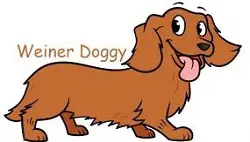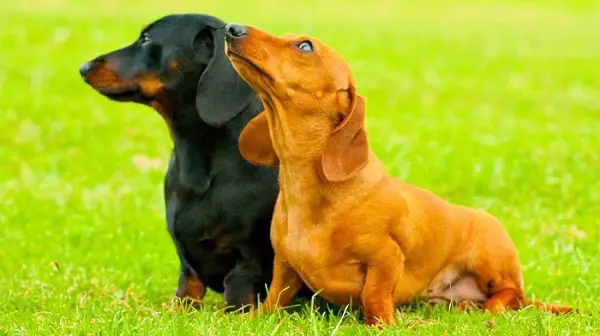Wondering what the differences are between Miniature Dachshund vs Standard Dachshund? We’ve got five fascinating facts you should know.
Here are the differences you want to know before choosing between the miniature dachshund vs standard dachshund.
Miniature Dachshund vs Standard Facts
1. Size of the miniature dachshund is only 5 to 6 inches tall, while the Standard Dachshund is between 8 and 9 inches tall. The Standard Dachshund weighs from 16 to 32 pounds, while the Miniature Dachshund weighs from 9 to 15 pounds.
2. The Miniature Dachshund has a greater skeletal structure as compared to other Dachshund breeds. Its body is longer but shorter than the Standard Dachshund.
This characteristic of the Miniature Dachshund is particularly attractive to parents who are looking for a smaller dog that is not overwhelming to walk around with.
3. The Miniature Dachshund usually ends up with a lighter fur coat. Both miniature dachshunds vs standard come in many colors; brown, black, red, gray, fawn, cream, and wild boar. The patterns in any size dachshunds are dapple, brindle, and piebald.
There are three coat varieties with both miniature dachshunds vs standard. They are smooth- haired, wire-haired, and long-haired. The wire-haired personality is a bit more tenacious, whereas the long-haired is a bit more easy going.
However, all dachshunds are stubborn, notorious barkers, and can be aggressive towards other dogs and strangers.
RELATED: Long Haired Dachshund – Miniature vs Standard
4. The similarities between a miniature dachshund vs standard are that both have short bodies, moderately long legs, with a sloping back. They also both have large heads and thick ears. The only difference is that a Miniature Dachshund has a more elongated head.
5. The Miniature Dachshund vs standard for dog training is that the miniature is a bit harder to train because it does not go along with the pack mentality. Even though the Miniature Dachshund is hard to train, both will make great pets. All Dachshunds are very energetic and love to play and fetch.
The Miniature Dachshund has a delicate bone structure and these features are further accentuated by a number of creases. Many of these creases are found on the face and the neck of the Dachshund.
In addition to the excellent size and quality, the miniature Dachshund has a gentle nature and can be quite affectionate toward its owners. It can make a wonderful companion dog.
As far as appearance is concerned, the Miniature Dachshund has long ears and hair that are long, curly, and loosely coiled. The outer coat of the Dachshund is white, and the underside of the coat has yellow or cream colors.
Traits of Miniature Dachshunds
The lifespan of the miniature dachshund can be a 13-17 years where the standard dachshund is 12-16 years on average.
The Miniature Dachshund is not only a lively and active puppy but also shows off its intelligence when it is playing. This is a great reason to have a Miniature Dachshund, as they can learn quickly about playing fetch and other dog activities.
Since you are interested in purchasing a Miniature Dachshund puppy, these are some of the basics that you need to know.
One of the best traits of the Dachshund is the fact that it is very quick. It runs and jumps around and can make you laugh. They also love to sniff and have a great nose to sniff things out. You can also learn a lot about the Dachshund from the way it is very active and curious.
However, if the Miniature Dachshund is to be left unattended in the house, it can be a very dangerous situation. The Dachshund is very protective of its territory. If you leave it alone in the house, it could become aggressive if a stranger comes to the door.
Their predisposition to hunt has left the Dachshund with an independent streak that can lead to stubbornness and an instinct to chase small animals.
The main health problem with both Miniature Dachshunds vs standards is their backs. Since they have long backs, intervertebral disc disease has been an issue for this breed.
Intervertebral disc disease happens when a disc protrudes into the spinal column, causing severe pain and nerve damage.
The Dachshund breed has 10-12 times more likely to have intervertebral disc disease than any other breed. And 1 out of every 4 dachshunds is likely to get IVDD. Older dachshunds, especially ones that are overweight and inactive are more likely to get IVDD.
So a key is to make sure your dachshund doesn’t develop a weight problem. I would recommend feeding them high-quality dog food and taking them on a regular walk for exercise.
Also, make sure you don’t let them jump up or down on couches or beds, as this can cause back issues. They should never run up and down the stairs either.
In addition, I would recommend Glucosamine and Chondroitin. I give my 14 year old dachshund this every day and he has never had any back issues.
Both Standard and Miniature Dachshunds have moderate shedding.
Obviously, the smooth-haired Dachshund requires little maintenance, as a general brushing once a week will keep their coat shiny.
The wire-haired Dachshund requires brushing several times a week, while the long-haired Dachshund requires daily brushing.
Remember to have their nails clipped once or twice a month. All dachshunds need to have their ears cleaned otherwise they are prone to having ear infections.
I bathe my dachshund every two weeks and clean his ears after his bath. I find it amusing as many dachshunds do not like a bath, yet my dachshund looks forward to his. In fact, he will howl and run into the shower tub when I say the word “bath”. He loves the warm water.


